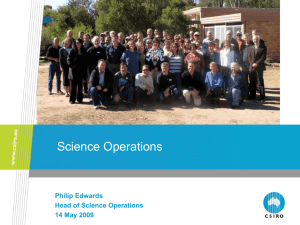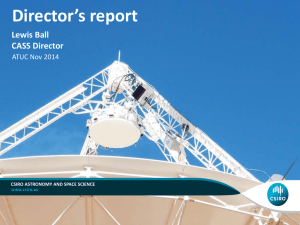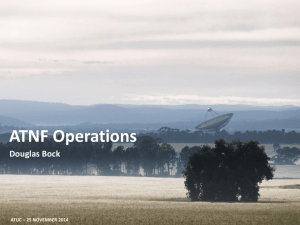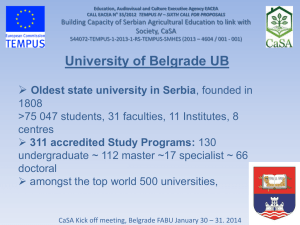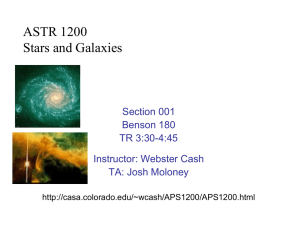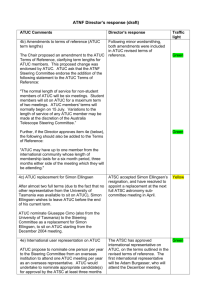Future CABB data reduction - Australia Telescope National Facility
advertisement
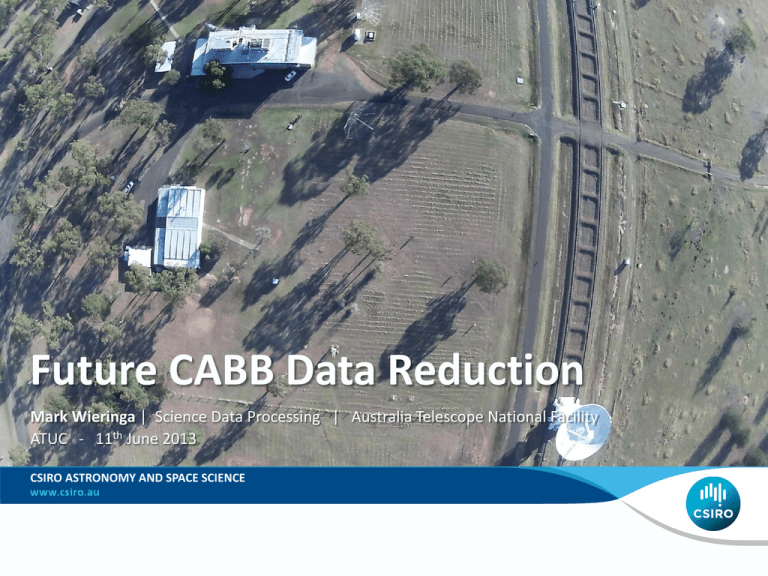
Future CABB Data Reduction Mark Wieringa | Science Data Processing | Australia Telescope National Facility ATUC - 11th June 2013 CSIRO ASTRONOMY AND SPACE SCIENCE Miriad improvements for CABB • Cope with increased data size (>8GB) • up to 70000 channels, image sizes up to 327682 • Calibration in up to 16 frequency bins (gpcal, selfcal) • Solutions interpolated in time and frequency • Fixes phase slope across band • Removes effect of secondary calibrator spectrum • Solves leakage terms vs frequency • Better data flagging capabilities • • New flagging task pgflag with automatic flagging mode (SumThreshold alg.) Blflag improvements – plot vs channel, cope with more data • Source fitting with spectral index and curvature (uvsfit, uvfit binning) • Frequency dependent primary beam correction • Linmos bw parameter, restor mfs option ATUC -- 30 October 2012 Miriad limitations • Imaging algorithms • Mfclean – intensity and spectral index term only (limits fractional bandwidth to <50%, errors on edge of primary beam) • Clean algorithms don’t cope well with extended emission, MEM algorithms don’t do MFS • Mosaicing – no MFS (mosmem, mossdi), primary beam at fixed frequency • No major cycle clean that subtracts from ungridded data – DR limitations • No automatic source detection and cleaning • Image cubes use single beam plane • Ad hoc analysis • No tools to get easy access to data from scripts ATUC -- 30 October 2012 ATUC -- 30 October 2012 Report Conclusion “The committee has surveyed the shortcomings of Miriad when faced with the calibration and imaging of recent CABB data. Taking into account the limited resources available, a number of minor improvements to Miriad have been suggested and prioritised, totaling a few months of development. In addition the committee suggests that both the CASA and ASKAPSoft packages are used to supplement the imaging and analysis tasks available in Miriad. Documentation of the process to get data into these packages (and back) and recipes or scripts for further processing should be provided.” ATUC -- 30 October 2012 CABB data reduction with CASA • Latest release: CASA 4.1.0 (31 May 2013) • Main features of interest: • • • • Multi-scale, multi-frequency clean (MSMFS) – now working well for single fields Can use multi-scale clean (but not yet MFS) for mosaics Cube imaging with beam per channel, can clean planes in parallel A-projection – cope with time and baseline dependent primary beam effects (no MFS yet) • Drawbacks: • • No native filler for rpfits yet. Use FITS export/import or new uv2ms task in linux Miriad Imaging can be slow – factor 10-20 compared to Miriad • EVLA has all of CABB’s problems and more (non-coplanar, beam squint) • Solutions will appear in CASA over time (research topic) • CASA/CABB data reduction workshop • • Jamie Stevens will organize this if there is sufficient community interest Can now calibrate & image CABB Stokes I, continuum & spectral line data in CASA • Polarization still needs testing ATUC -- 30 October 2012 Data Reduction Recommendations • Load data into Miriad for calibration and flagging • Produce first pass images If quality of images limited by • extended emission • spectral structure • primary beam structure • Apply calibration, Convert to MeasurementSet • Produce images with CASA • MSMFS algorithm • A-projection algorithm (need Voltage patterns for ATCA antennas) ATUC -- 30 October 2012 Plans for Miriad • Bug fixes • Minor features, calibration improvements • No major work on imaging • Provide easy transfer to CASA ATUC -- 30 October 2012 Plans for CASA • Workshop • ATCA CASA Data Reduction Cookbook • Start contributing ATCA/CABB specific work • Primary beam models • Calibrator models • Contribute ASKAPSoft imaging algorithms • Re-implement in CASA ATUC -- 30 October 2012 Thank you CSIRO Astronomy and Space Science Mark Wieringa Science Data Processing t +61 2 67904040 e mark.wieringa@csiro.au w www.atnf.csiro.au CSIRO ASTRONOMY AND SPACE SCIENCE

